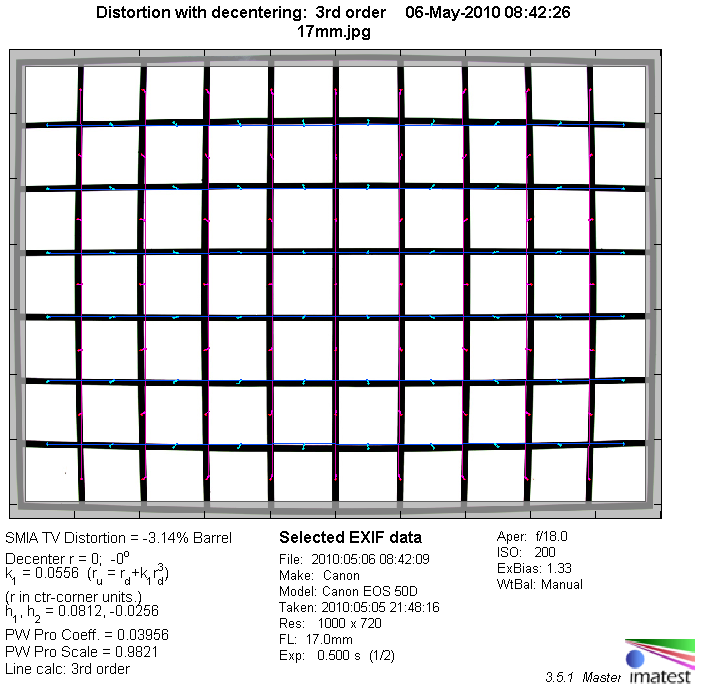|
Sigma AF 17-70mm f/2.8-4 DC HSM OS macro - Lab Test / Review - Analysis |
|
Lens Reviews -
Canon EOS (APS-C)
|
|
Page 2 of 2

Distortion
The distortion figures of the Sigma 17-70mm OS are fairly typical for a relatively long range standard zoom lens. At 17mm it shows very pronounced barrel distortion (~3.1%) and slight pincushion distortion at longer focal lengths. The two opposing distortion types even out at around 24mm where images are basically distortion-free.
|
Move the mouse cursor over the focal length text marks below to observe the respective distortion
|
| 17mm |
24mm |
40mm |
70mm |

|
The chart above has a real-world size of about 120x80cm.
Vignetting
The light fall-off is, unsurprisingly, most pronounced at 17mm @ f/2.8. At around ~1.3EV the issue will be noticeable in some situations here. Stopping down to f/4 resolves most of the problem and it's not field relevant anymore from f/5.6 onwards. Longer focal lengths show a more moderate characteristic here.

MTF (resolution)
The Sigma lens has a very similar resolution characteristic like its non-OS cousin.
The center performance is very fine straight at 17mm @ f/2.8 and it even gets excellent when stopping down. The borders start with good figures here whereas the corners are somewhat soft and you should stop down to f/4 to overcome these corner problems. The peak performance is reached at f/5.6 with a generally very good quality across the frame. The sweetest focal lengths are 24-40mm - it may not reach the stars but the lens shows no significant weakness anymore here. At 70mm there's a more pronounced drop in contrast at f/4 and the measured center figures weren't quite as good here anymore. However, the resolution remains fine and the contrasts get somewhat more snappier from f/5.6 onwards.
The lens wasn't perfectly centered which is not uncommon for lenses with an optical image stabilizer.
Please note that the MTF results are not directly comparable across the different systems!
Below is a simplified summary of the formal findings. The chart shows line widths per picture height (LW/PH) which can be taken as a measure for sharpness.
If you want to know more about the MTF50 figures you may check out the corresponding Imatest Explanations
Chromatic Aberrations (CAs)
Lateral CAs (color shadows at harsh contrast transitions) are very well controlled including the critical 17mm setting. The average CA width at the borders varies around the 1px mark with a slight peak of ~1.3px at 17mm f/4. This may be noticeable at 100% image magnification on your screen but it's not really relevant anymore for prints.

VerdictThe Sigma AF 17-70mm f/2.8-4 DC HSM OS remains a fairly obvious candidate for budget oriented consumers. It may not reach stellar performance levels but the resolution figures are generally very decent. However, you may try to avoid the f/2.8 setting at 17mm due to fairly soft corners and high vignetting. Like most standard zoom lenses it shows a pronounced degree of barrel distortion at 17mm whereas other focal lengths are less affected. Lateral CAs are comparatively well corrected. All-in-all the results are almost surprisingly similar to its predecessor.
That said this new version features an improved AF motor ("hypersonic" vs micro-motor) and there's naturally the highly efficient OS - Sigma's optical image stabilizer - which is just as efficient as Canon's IS. The build quality of the lens is pretty impressive for a lens in this class and a nice contrast compared to the average plastic bomber here. The pricing of the Sigma lens is, as usual, highly competitive especially when taking the relatively large max. aperture in account.
|